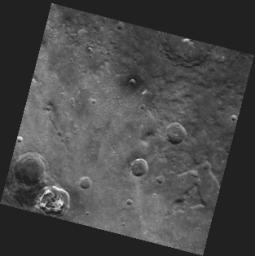The crater with bright material in the lower left corner of this image is the newly named Balanchine crater. Shown here in spectacular high resolution, Balanchine crater is one of 23 Mercury craters recently assigned names by the IAU. This crater was named for George Balanchine, one of the most famous choreographers of the 20th century and co-founder of the New York City Ballet.
This image was acquired as part of MDIS's 8-color base map. The 8-color base map is composed of WAC images taken through eight different narrow-band color filters and covers more than 99% of Mercury's surface with an average resolution of 1 kilometer/pixel. The highest-quality color images are obtained for Mercury's surface when both the spacecraft and the Sun are overhead, so these images typically are taken with viewing conditions of low incidence and emission angles.
Date acquired: December 22, 2011
Image Mission Elapsed Time (MET): 233051806
Image ID: 1168956
Instrument: Wide Angle Camera (WAC) of the Mercury Dual Imaging System (MDIS)
WAC filter: 9 (996 nanometers)
Center Latitude: 40.36°
Center Longitude: 178.0° E
Resolution: 887 meters/pixel
Scale: Balanchine crater is 36 km (22 miles) in diameter
Incidence Angle: 41.3°
Emission Angle: 0.3°
Phase Angle: 41.0°
The MESSENGER spacecraft is the first ever to orbit the planet Mercury, and the spacecraft's seven scientific instruments and radio science investigation are unraveling the history and evolution of the Solar System's innermost planet. Visit the Why Mercury? section of this website to learn more about the key science questions that the MESSENGER mission is addressing. During the one-year primary mission, MDIS acquired 88,746 images and extensive other data sets. MESSENGER is now in a year-long extended mission, during which plans call for the acquisition of more than 80,000 additional images to support MESSENGER's science goals.
These images are from MESSENGER, a NASA Discovery mission to conduct the first orbital study of the innermost planet, Mercury. For information regarding the use of images, see the MESSENGER image use policy.

 Planetary Data System
Planetary Data System












